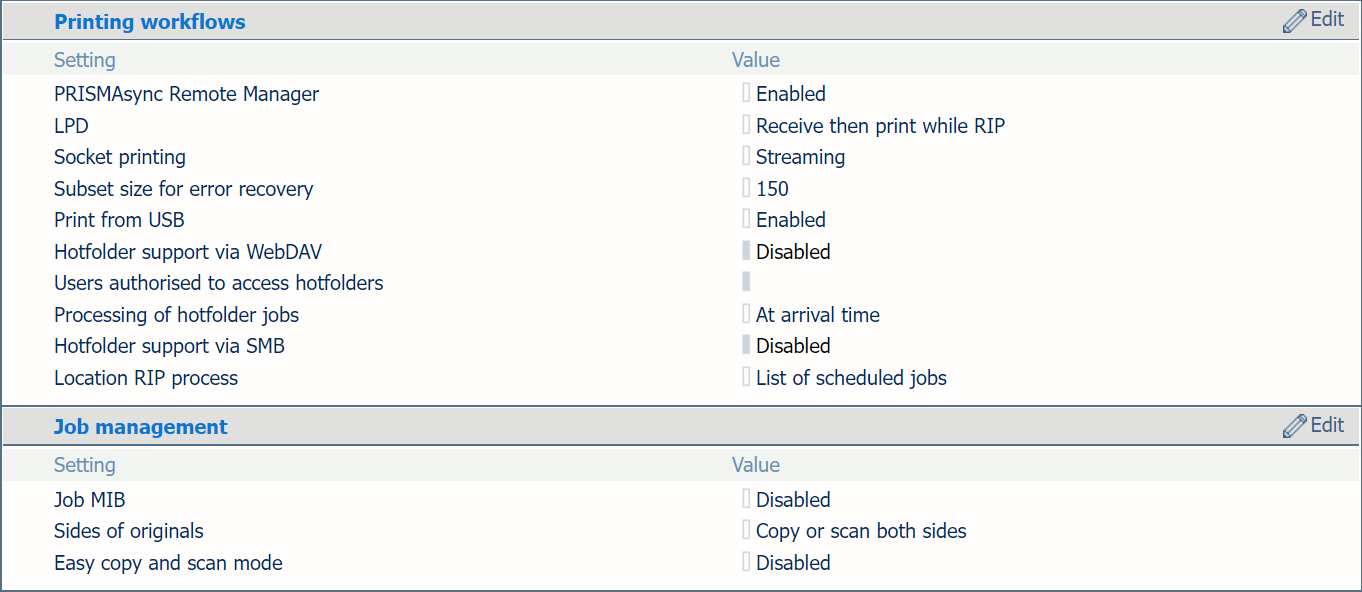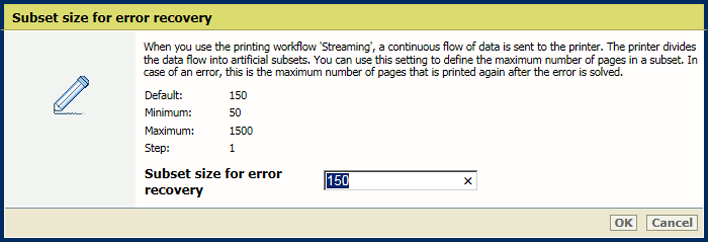

You can define how jobs are processed by default.
Open the Settings Editor and go to: .
 [Paramètres du système] tab
[Paramètres du système] tabGo to the [Flux de traitement des impressions] and [Gestion des travaux] sections.
 [Flux de traitement des impressions] and [Gestion des travaux] sections
[Flux de traitement des impressions] and [Gestion des travaux] sectionsThe printer protocol LPD can be enabled by the system administrator. The print protocol LPR must be installed on the workstation that submits the jobs.
Use the [LPD] setting to indicate when the RIP starts to process LPR jobs.
[En continu] is applicable to large jobs. The job is processed by the RIP and printing can start at the same time.
[Réception, puis impression pendant la rastérisation] is the default value and is applicable to smaller jobs that have multiple sets. The RIP starts to process the jobs after they arrive in the print queue and before the whole job has been received.
 [LPD] setting
[LPD] settingSocket printing can be enabled and configured by the system administrator.
Use the [Impression socket] setting to indicate when the RIP starts to process jobs that use the socket printing port.
[En continu]: is default value and applicable to large jobs. The job is processed by the RIP and printing can start at the same time.
[Réception, puis impression pendant la rastérisation]: is applicable to for smaller jobs that have multiple sets. The RIP starts to process the jobs after they arrive in the print queue and before the whole job has been received.
 [Impression socket] setting
[Impression socket] settingUse the [Taille du sous-jeu pour la correction des erreurs] setting to define the number of pages that will be printed again after the error is solved.
 [Taille du sous-jeu pour la correction des erreurs] setting
[Taille du sous-jeu pour la correction des erreurs] settingThe system administrator can change the processing order of hotfolder jobs.
Use the [Traitement en cours des travaux du dossier actif] setting to indicate how jobs are processed in the hotfolder.
[A l'heure d'arrivée]: job processing takes place when the job arrives in the hotfolder.
[Ordre basé sur nom du travail]: job processing takes place according to the alphabetical order of the job names.
 [Traitement en cours des travaux du dossier actif] setting
[Traitement en cours des travaux du dossier actif] settingUse the [Impression à partir d'une clé USB] setting to indicate whether printing from a USB drive is allowed.
 [Impression à partir d'une clé USB] setting
[Impression à partir d'une clé USB] settingUse the [Emplacement du processus RIP] setting to indicate where the RIP processes jobs when they arrive in the print queue.
[Tous les emplacements]: the RIP can process jobs in all job destinations.
[Liste des travaux programmés]: the RIP can only process jobs when they are in the list of scheduled jobs.
 [Emplacement du processus RIP] setting
[Emplacement du processus RIP] settingUse the [MIB du travail] setting to indicate if remote monitoring of jobs via SNMP is allowed.
 [MIB du travail] setting
[MIB du travail] settingUse the [Faces d’originaux] setting to indicate if originals have information on one or both sides.
 [Faces d’originaux] setting
[Faces d’originaux] settingUse the [Mode de numérisation et de copie facile] setting to indicate that you want to enable the easy copy and scan mode.
[Activé]: the last used job template will be re-opened when the operator starts a new copy or scan job.
[Désactivé]: the last used job template will close when the operator starts a new copy or scan job.
 [Mode de numérisation et de copie facile] setting
[Mode de numérisation et de copie facile] setting